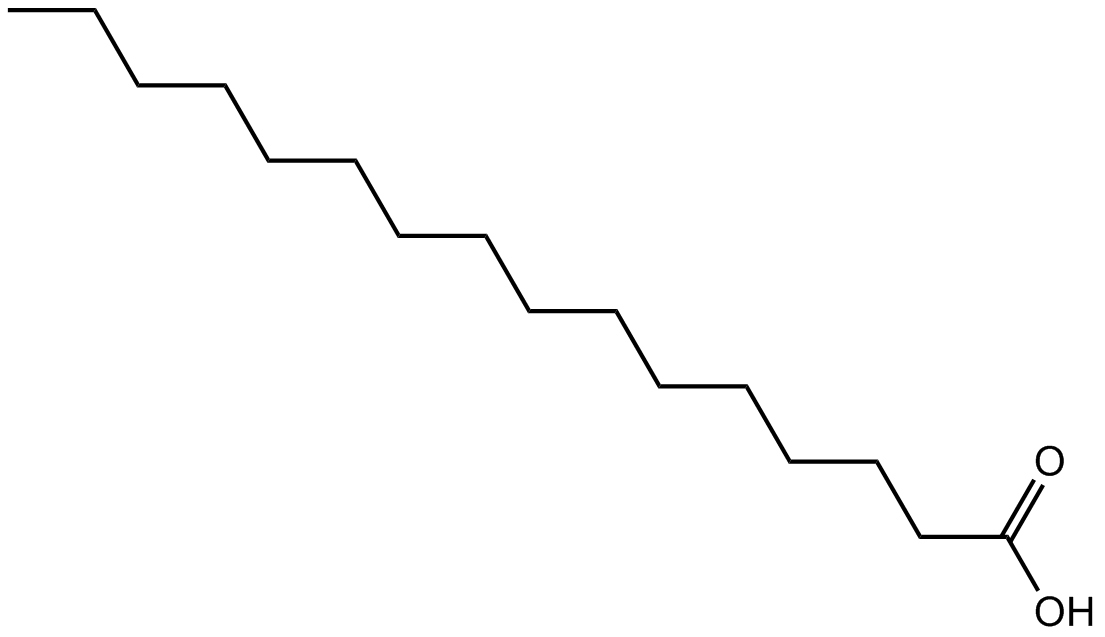Palmitic acid (Synonyms: C16:0, Cetylic Acid) |
| Catalog No.GN10676 |
A long-chain saturated fatty acid
Products are for research use only. Not for human use. We do not sell to patients.

Cas No.: 1957/10/3
Sample solution is provided at 25 µL, 10mM.
Palmitic acid (PA) is the most common saturated fatty acid found in the human body and can be provided in the diet or synthesized endogenously from other fatty acids, carbohydrates and amino acids[9].
Palmitic acid treatment decreased cell viability in a dose-dependent manner, and the minimum effective dose was 100 μM Palmitic acid. Palmitic acid treatment increased the percentage of apoptotic Saos-2 cells in a dose-dependent manner, IC50 value is about 200 μM[3]. Obesity-related neurodegenerative diseases are associated with elevated saturated fatty acids (SFAs) in the brain. Palmitic acid induces significant neuron cell cycle arrest in the G2/M phase in SH-SY5Y cells[2]. Palmitic acid was able to cause an increase in autophagic flux. PA-induced autophagy was found to be independent of mTOR regulation. Inhibition of autophagy sensitized the cells to Palmitic acid-induced apoptosis, suggesting the pro-survival function of autophagy induced by Palmitic acid [4]. Treatment of SMMC-7721 cells with Palmitic acid increased LC3-II expression in time- and dose-dependent manners, whereas the unsaturated fatty acid oleic acid had no effect[5]. Palmitic acid can induce the expression of glucose-regulated protein 78 (GRP78) and CCAAT/enhancer binding protein homologous protein (CHOP) in in mouse granulosa cells[1].
Transient higher levels of Palmitic acid exposure in pregnant mice activates NLRP3 inflammasome and induces placental inflammation, resulting in the incidence of absorption[6]. In a dose-dependent fashion, palmitic acid rapidly reduced mouse locomotor activity by a mechanism that did not rely on TLR4, MyD88, IL-1, IL-6 or TNFα but was dependent on fatty acid chain length. Twenty-four hours after palmitic acid administration mice exhibited anxiety-like behavior without impairment in locomotion, food intake, depressive-like behavior or spatial memory. Additionally, the serotonin metabolite 5-HIAA was increased by 33% in the amygdala 24h after palmitic acid treatment[7]. Palmitic acid treatment in mice enhances resistance to Brucella infection and is accompanied by attenuated IL-10 induction during Brucella infection[8].
References:
[1]. Harada H, Yamashita U, et,al. Antitumor activity of palmitic acid found as a selective cytotoxic substance in a marine red alga. Anticancer Res. 2002 Sep-Oct;22(5):2587-90. PMID: 12529968.
[2]. Hsiao YH, Lin CI, et,al.Palmitic acid-induced neuron cell cycle G2/M arrest and endoplasmic reticular stress through protein palmitoylation in SH-SY5Y human neuroblastoma cells. Int J Mol Sci. 2014 Nov 13;15(11):20876-99. doi: 10.3390/ijms151120876. PMID: 25402647; PMCID: PMC4264201.
[3]. Yang L, Guan G, et,al.Palmitic acid induces human osteoblast-like Saos-2 cell apoptosis via endoplasmic reticulum stress and autophagy. Cell Stress Chaperones. 2018 Nov;23(6):1283-1294. doi: 10.1007/s12192-018-0936-8. Epub 2018 Sep 7. PMID: 30194633; PMCID: PMC6237680.
[4]. Tan SH, Shui G, et,al. Induction of autophagy by palmitic acid via protein kinase C-mediated signaling pathway independent of mTOR (mammalian target of rapamycin). J Biol Chem. 2012 Apr 27;287(18):14364-76. doi: 10.1074/jbc.M111.294157. Epub 2012 Mar 9. Erratum in: J Biol Chem. 2014 Apr 4;289(14):9501. PMID: 22408252; PMCID: PMC3340233.
[5]. Tu QQ, Zheng RY, et,al.Palmitic acid induces autophagy in hepatocytes via JNK2 activation. Acta Pharmacol Sin. 2014 Apr;35(4):504-12. doi: 10.1038/aps.2013.170. Epub 2014 Mar 10. PMID: 24608675; PMCID: PMC4813717.
[6]. Sano M, Shimazaki S, et,al. Palmitic acid activates NLRP3 inflammasome and induces placental inflammation during pregnancy in mice. J Reprod Dev. 2020 Jun 12;66(3):241-248. doi: 10.1262/jrd.2020-007. Epub 2020 Feb 27. PMID: 32101829; PMCID: PMC7297640.
[7]. Moon ML, Joesting JJ, et,al.The saturated fatty acid, palmitic acid, induces anxiety-like behavior in mice. Metabolism. 2014 Sep;63(9):1131-40. doi: 10.1016/j.metabol.2014.06.002. Epub 2014 Jun 9. PMID: 25016520; PMCID: PMC4151238.
[8]. Reyes AWB, Huy TXN,et,al. Protection of palmitic acid treatment in RAW264.7 cells and BALB/c mice during Brucella abortus 544 infection. J Vet Sci. 2021 Mar;22(2):e18. doi: 10.4142/jvs.2021.22.e18. PMID: 33774934; PMCID: PMC8007444.
[9].Carta G, Murru E, Banni S, Manca C. Palmitic Acid: Physiological Role, Metabolism and Nutritional Implications. Front Physiol. 2017 Nov 8;8:902. doi: 10.3389/fphys.2017.00902. PMID: 29167646; PMCID: PMC5682332.
Average Rating: 5 (Based on Reviews and 30 reference(s) in Google Scholar.)
GLPBIO products are for RESEARCH USE ONLY. Please make sure your review or question is research based.
Required fields are marked with *




